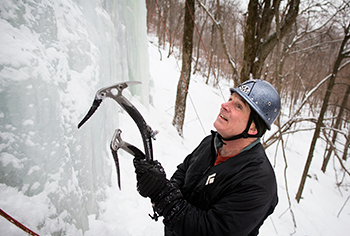Leadership Training in Adverse Conditions
SUNY Potsdam’s wilderness education program has been cultivating student leaders for the past 20 years. Mark Simon started the program in 1996, taking what was then just a collection of physical education classes and turning it into an extensive wilderness leadership program.
 |
|
|
Simon reflected on the early years, “The first semester I was there, I just started teaching what I could in the outdoors, pretty short-term weekend experiences. And what we’ve done is turned it into more high impact learning.”
The program now offers 17 classes taught by Mr. Simon, Adam Wheeler and Matt Hosmer. They range from rock and ice climbing to wilderness first responder training and an extensive leadership course where students plan and execute a 21-day backpacking trip.
Potsdam and the surrounding wilderness provides the perfect outdoor classroom for students to build their leadership and team building skills. The College is located about 10 miles northwest from the entrance to the Adirondack State Park in Parishville. “Most of what we do around here is within 35-50 miles of campus, so it’s just real economical for us,” Simon said.
On a recent ice climbing trip to Mt. Azure, 48 miles from Potsdam, Alumna Alaina Goodrich ’09, stands at the base of a rock wall covered in ice while belaying a fellow ice climber. Eight years after graduating from SUNY Potsdam, she is back taking Simon’s ice climbing class. “It’s good to get out into the wilderness where it’s peaceful. The people are great. It’s a certain type of person that enjoys being in the outdoors and pushing their limits. It’s fun to be around those types of people.”
The ice climbing class is an intensive two-week course at the College where students learn skills in a classroom setting and then hike to a remote ice climbing site to use crampons and ice axes as they ascend a frozen cliff. Brandon Keough, a wilderness education minor from Rochester, was one of those students ascending the ice wall earlier this month. “Problem solving and making critical decisions in adverse conditions sets a high bar for my performance as a leader, thus allowing me to tackle situations in my daily life with ease.”
“The whole premise behind the program is student leadership development,” Simon said. Students lead backpacking classes, oversee the rock wall and manage the ropes course. “We wouldn’t be able to run this program without them. We utilize our own student leaders. While they’re here, they gain a lot of leadership experience.” He explained that he doesn’t know of another program that utilizes student leadership to the extent that SUNY Potsdam does.Sophomore Greg Larbi, who is originally from Ghana but moved to the Bronx in 2012, said that he recently declared wilderness education as his minor. Before arriving in Potsdam, he had no prior experience, except for one trip to an indoor rock climbing wall in the city. “The backpacking experience was totally new to me and pretty exciting,” he said.
Larbi became interested in the program because of the students. He said that most of the classes have to do with teamwork and team building. “We depend on each other and trust one another.” The trust and teamwork is essential when working on rock climbing skills such as belaying your climbing partner and building anchor systems for the climb.
Larbi said that the technical skills he has learned range from tying knots to rope rappelling to the hanging of bear bags. “Remember to hang your bear bags, because it’s better to lose all your food than to be eaten by a bear,” he joked. His favorite experience so far has been interacting with classmates around a campfire on his backpacking trip where they told stories and made food together.
Simon reflected on one of the program’s more intensive outdoor adventures. “The culminating experience for the leadership track is a 21-day expedition out west.” He noted that there have been challenges while preparing for recent trips, due to climate change that has affected the terrain. For instance, last summer’s planned excursion to the Gila Wilderness Area in New Mexico was changed to Northern Montana because the snow pack disappeared several months earlier, a noted change from years past.
Simon is very impressed with the students entering the program, such as Dolma Lhamo, who grew up in Kham, a small village in Tibet. Her parents wanted her to have a better education, so she moved to Queens in 2006. Now a senior, Lhamo said her favorite adventures have been her backpacking and wilderness leadership courses, where she gained a lot of hands-on skills and leadership experiences. “They helped me to be someone stronger and come out of my comfort zone.” She praised her classmates, noting their positive influence on her life.
Looking to the future, Simon said that he looks forward to implementing a new concentration in wilderness education within the curriculum and instruction graduate program. The concentration will focus on preparing students to implement wilderness education programs in a k-12 setting in public schools.
The program has grown extensively over the past 20 years. Simon said, “the future of the wilderness education program will be shaped by our pursuit of new and challenging applied learning experiences in wilderness settings.”
